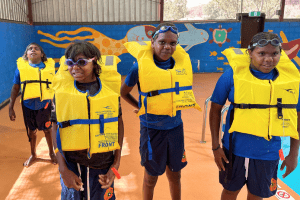Warakurna kids Swim for Fruit
 Kids in the remote community of Warakurna were introduced to the Swim for Fruit program for the last month during their Department of Education swimming lessons.
Kids in the remote community of Warakurna were introduced to the Swim for Fruit program for the last month during their Department of Education swimming lessons.
Royal Life Saving WA Swimming Instructor and former Remote Pool Manager Bernie Egan was in Warakurna delivering swimming lessons when she decided to test out the program with the kids.
Working with local Pool Manager Lily, Bernie was able to get some apples at a discounted price of $2 each, despite not much variety being available due to the fact that the truck delivering fresh food would not be coming until later in the week.

Ten children participated in the program despite the cold weather, and Bernie talked with them about the importance of eating good, healthy foods. As word got out that there were apples available, more children began attending and a second program was run just two days later!
Royal Life Saving WA hope to continue working with the local community to continue running this program throughout the rest of the summer.
The Go for 2&5 Regional and Remote Aboriginal Communities Swimming Program (Swim for Fruit) supports after-school and weekend lap swimming, expanding on the Swim and Survive program for Aboriginal communities in regional and remote areas of Western Australia. Children earn fresh fruit as a reward for completing laps or aquatic challenges, encouraging regular participation in sport.
Healthway has supported the program since 2009 and has been working together with Royal Life Saving WA to ensure children across regional WA have an opportunity to improve their swimming and water safety skills and learn about the importance of eating more fruit and vegetables through the Go for 2&5 program.
This is especially crucial considering the fact that fresh fruit is often less available and more unaffordable in remote communities. Additionally, Aboriginal Australians face higher disease and death rates and are 3.6 times more likely to drown than non-Aboriginal Australians.

Expanding the school-based Swim and Survive program also aims to boost involvement in aquatic sports like water polo, competitive swimming, and pool lifesaving, helping build healthier, safer communities.
Keen to learn more or thinking about starting your own Swim for Fruit program? Click the link below for more information.
